TEN THINGS YOU NEED TO KNOW ABOUT MUFFLERS
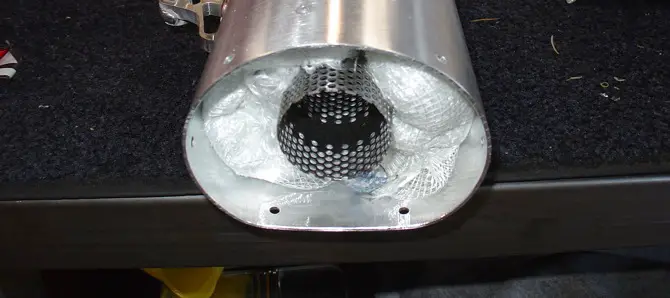
(1) Parts list. An aftermarket exhaust system is the most popular way to increase power. A pipe is relatively simple to install, offers good power gains, and is visible on the bike (for showing off). An aftermarket muffler has the potential for decreasing sound and increasing performance at the same time. There are 80 parts and almost 100 operations that go into making an exhaust system?the majority of these in the muffler’s construction.
(2) Basics. A basic muffler consists of a canister, inlet cap, perforated core, packing and an end cap. Other design details are small cosmetic features, performance-specific resonance chambers, tapered cores, reducer rings and non-perf sections. Additionally, mufflers can be equipped with removable inserts, spark arrestors, replaceable end caps and different size stingers. Virtually every aftermarket exhaust pipe comes with a spark arrestor screen, installed or in the box, to allow the pipe to be used in designated areas where the law requires spark arrestors. As a rule, spark arrestors don’t have much effect on peak horsepower, but do lessen throttle response.
(3) Frequency. A reciprocating engine is an air pump, constantly putting out high- and low-pressure frequency waves. While developing an exhaust system, a pipe builder can play with the overall length, tube diameters, various tapers, bends of the pipe, core size, end-cap diameter, holes, perforations and resonance chambers to achieve the performance he wants.
(4) Pressure wave. The pressure waves are also responsible for the noise. Builders try to lower sound by disrupting and diffusing the pressure wave. A perforated core, resonance chamber and mechanical chambers work to that end. The simplest and easiest way to make a pipe quieter is to reduce the core and outlet diameter, but technically, a designer should try to diffuse the pressure wave before choking the engine down.
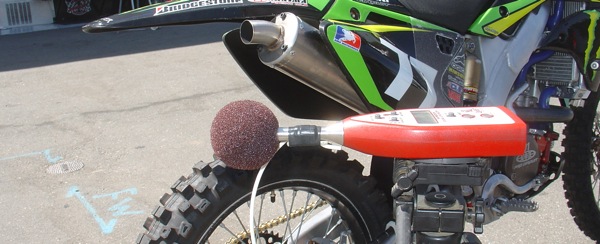
(5) Moving target. Starting in 2011, the Japanese manufacturers were focused on designing an exhaust system that passes the AMA 94 dB sound test (measured at 20 inches away at a very low rpm). What they didn’t know and couldn’t respond to was that the AMA was going to switch to the FIM’s 115 dB two-meter-max test (measured with the throttle wide open at six feet) for 2011. Or that the AMA plans to go to a 112 dB standard in 2014. Only a handful of stock Japanese exhausts can pass the two-meter-max test, but KTM manages to pass both the two-meter-max and the AMA 94 dB test. The two-meter-max test produces quieter motorcycles than the AMA 94 dB test?because it tests the exhaust noise at throttle settings that are more like the real world.
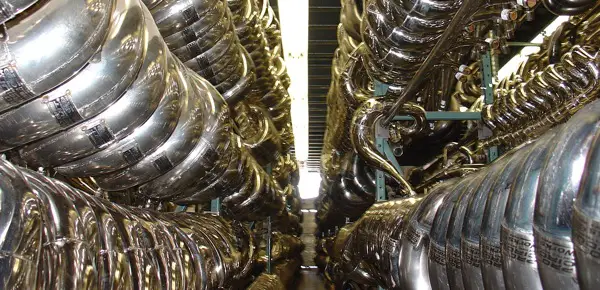
(6) Two-stroke. Two-stroke engines have different exhaust systems, but the basic muffler design is similar. A two-stroke pipe uses its reflective pressure wave to keep the fuel/air mixture inside the combustion chamber. Most of this tuning is done in the pipe itself, but muffler length and diameter play a part. Two-stroke sound waves do not travel as far as four-stroke waves, which is why sound issues quadrupled with the popularity of four-stroke motocross bikes.
(7) Weight. Aftermarket exhaust systems tend to be lighter than OEM exhausts?partially because they often use more exotic materials in the tubing, but largely because the muffler is the prime opportunity for weight savings. A basic OEM muffler design uses stainless steel and aluminum. Aftermarket pipes can use titanium, aluminum or carbon fiber for the canisters (and titanium or carbon fiber for the end caps). The exotic materials bring the weight down while making the price go up. But don’t confuse the performance of a $1200 titanium/carbon fiber pipe with that of a $600 stainless/aluminum system. There is no power difference between one brand’s high-end and low-end pipes. If you are looking for more bang for your buck, consider a slip-on exhaust. It does not come with a new head pipe, but is new from the mid-pipe back. On many bikes, slip-ons offer as much power gain as the comparable full system.
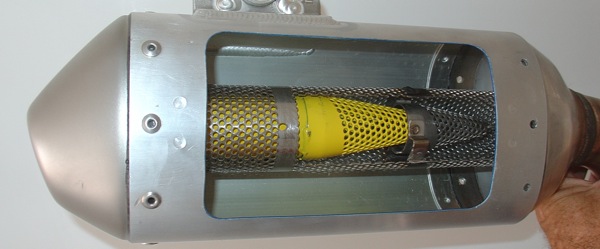
(8) Baffling. As a rule, motocross bikes, with the exception of the infamous 2009 Yamaha YZ450F ice cream cone muffler (above), do not use baffling, multiple venture chambers or other obstructions. The standard-issue dirt bike muffler has a straight-through perforated core. Resonance chambers are the only sound-reducing trick that aftermarket exhaust companies embrace to trick the pressure wave. A resonance chamber is an empty space that is connected to the exhaust pipe via a small bleed hole. Some, like FMF Factory 4.1 exhaust systems, have two resonance chambers on the same pipe.
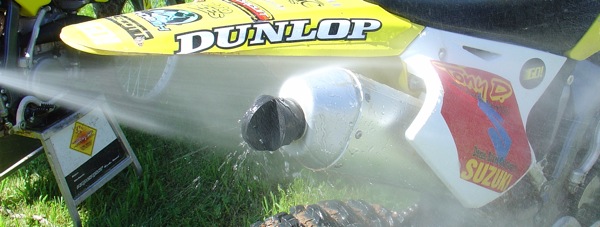
(9) Lifespan. Mufflers must be cared for. A bung plug, drying towel and WD-40 prevent water damage and rust. Repacking is necessary, although the time between repacking can vary depending on how hard the bike was ridden, the quality of the packing material and the muffler design. A blown-out muffler isn’t just louder, it loses performance, too.
(10) Repack. Muffler packing is a fiberglass material and is wrapped around the core (with a steel mesh layer between to deflect heat from the fragile fiberglass strands). Most exhaust pipe companies offer easy-to-install repacking kits.





Comments are closed.